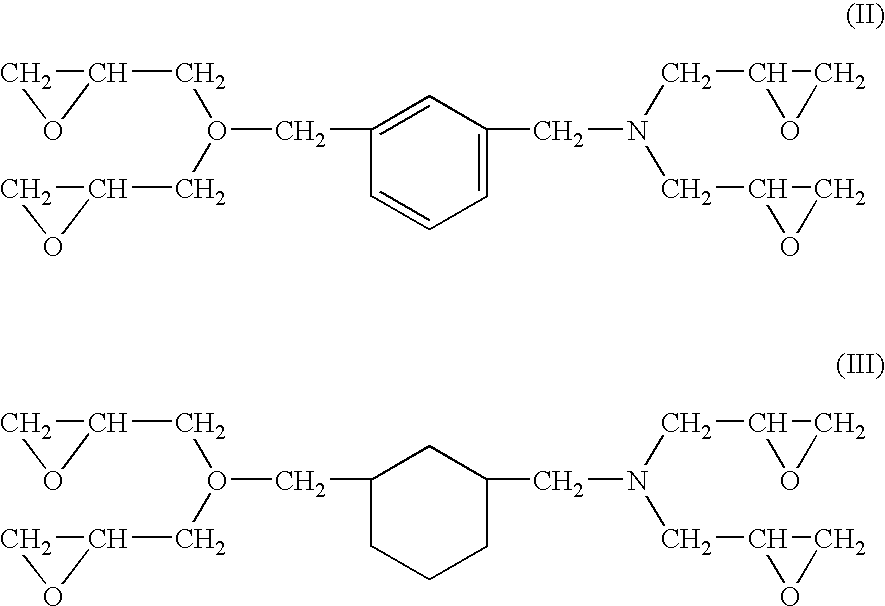Polyester film for use as an ink image receiving base film and ink
a polyester film and ink image technology, applied in the field of white biaxial oriented polyester film, can solve the problems of poor adhesion to the polyester film used as a base film, poor printability, and low productivity
- Summary
- Abstract
- Description
- Claims
- Application Information
AI Technical Summary
Benefits of technology
Problems solved by technology
Method used
Image
Examples
examples
[0082]The following examples are provided for the purpose of further illustrating the present invention but are in no way to be taken as limiting. The characteristic properties of the film were measured in accordance with the following methods.
(1) Secondary Transition Point
[0083]This is measured with the Thermal Analyst 2000 differential calorimeter of DuPont Co., Ltd. at a temperature increasing rate of 20° C. / min.
[0084]This is measured for viscosity of a solution in an orthochlorophenol solvent at 35° C.
[0085](3)-(a) Adhesion Before Printing
[0086]An aqueous slurry prepared by mixing 70 wt % of spherical silica (average particle diameter of 18 μm, average pore diameter of 200 Å, average pore volume of 1.5 cc / g) and 30 wt % of a polyvinyl alcohol (PVA117 of Kuraray Co., Ltd.) is applied to the coating film surface of a polyester film to a dry thickness of 20 μm, and Scotch tape (No. 600 of 3M Limited) having a width of 12.7 mm and a length of 150 mm is affixed...
example iv-1
[0136]A polyester (intrinsic viscosity of 0.62) composed of a terephthalic acid component and an ethylene glycol component was melt extruded onto a rotary cooling drum maintained at 20° C. to obtain an unstretched film which was then stretched to 3.6 times in a mechanical axis direction and coated with an aqueous solution composed of 65 wt % of a copolyester (Tg=30° C., to be simply referred to as “E” hereinafter)) which consisted of terephthalic acid (60 mol %), isophthalic acid (36 mol %) and 5-Na sulfoisophthalic acid (4 mol %) as acid components and ethylene glycol (60 mol %) and neopentyl glycol (40 mol %) as glycol components, 16 wt % of a polyvinyl alcohol having a saponification degree of 86 to 89 mol %, 10 wt % of crosslinked acrylic resin particles having an average particle diameter of 40 nm and 9 wt % of polyoxyethylene lauryl ether, and having a solid content of 4 wt % by a roll coater.
[0137]The longitudinally stretched film coated with the aqueous solution was stretche...
examples iv-(
27) and IV-(28) and Comparative Examples IV-(12) and IV-(13)
[0170]Biaxially oriented polyester films were obtained in the same manner as in Example IV-(1) except that the ratio of the copolyester (A), the water-soluble polymer (B) and the fine particles (C) was changed as shown in Table 10. The characteristic properties of the obtained laminate films are shown in Table 10.
[0171]
TABLE 10(B)(A)water-soluble(C) finefrictioncopolyesterpolymerparticlescoefficienttypewt %typewt %typewt %(μs)Ex. IV-(27)H72P16M 30.39Ex. IV-(28)H55P16M200.3C. Ex. IV-(12)H74P16M 10.62C. Ex. IV-(13)H48P16M270.31Ex.: Example C. Ex.: Comparative Example
[0172]As is obvious from the results shown in Table 10, the polyester film for receiving an ink jet printer image of the present invention is excellent in transportability.
PUM
| Property | Measurement | Unit |
|---|---|---|
| Temperature | aaaaa | aaaaa |
| Temperature | aaaaa | aaaaa |
| Length | aaaaa | aaaaa |
Abstract
Description
Claims
Application Information
 Login to View More
Login to View More - R&D
- Intellectual Property
- Life Sciences
- Materials
- Tech Scout
- Unparalleled Data Quality
- Higher Quality Content
- 60% Fewer Hallucinations
Browse by: Latest US Patents, China's latest patents, Technical Efficacy Thesaurus, Application Domain, Technology Topic, Popular Technical Reports.
© 2025 PatSnap. All rights reserved.Legal|Privacy policy|Modern Slavery Act Transparency Statement|Sitemap|About US| Contact US: help@patsnap.com



